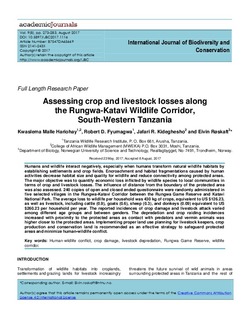| dc.contributor.author | Hariohay, Kwaslema Malle | |
| dc.contributor.author | Fyumagwa, Robert D. | |
| dc.contributor.author | Kideghesho, Jafari Ramadhani | |
| dc.contributor.author | Røskaft, Eivin | |
| dc.date.accessioned | 2019-07-04T10:51:33Z | |
| dc.date.available | 2019-07-04T10:51:33Z | |
| dc.date.created | 2018-01-12T08:25:23Z | |
| dc.date.issued | 2017 | |
| dc.identifier.citation | International Journal of Biodiversity and Conservation. 2017, 9 (8), 273-283. | nb_NO |
| dc.identifier.issn | 2141-243X | |
| dc.identifier.uri | http://hdl.handle.net/11250/2603389 | |
| dc.description.abstract | Humans and wildlife interact negatively, especially when humans transform natural wildlife habitats by establishing settlements and crop fields. Encroachment and habitat fragmentations caused by human activities decrease habitat size and quality for wildlife and reduce connectivity among protected areas. The major objective was to quantify economic loss inflicted by wildlife species to local communities in terms of crop and livestock losses. The influence of distance from the boundary of the protected area was also assessed. 240 copies of open and closed ended questionnaire were randomly administered in five selected villages in the Rungwa-Katavi Corridor between the Rungwa Game Reserve and Katavi National Park. The average loss to wildlife per household was 430 kg of crops, equivalent to US $126.23, as well as livestock, including cattle (0.9), goats (0.6), sheep (0.3), and donkeys (0.09) equivalent to US $260.23 per household per year. The reported incidences of crop damage and livestock attack varied among different age groups and between genders. The depredation and crop raiding incidences increased with proximity to the protected areas as contact with predators and vermin animals was higher closer to the protected areas. Implementing proper land use planning for livestock keepers, crop production and conservation land is recommended as an effective strategy to safeguard protected areas and minimize human-wildlife conflict. | nb_NO |
| dc.language.iso | eng | nb_NO |
| dc.publisher | Academic Journals | nb_NO |
| dc.rights | Navngivelse 4.0 Internasjonal | * |
| dc.rights.uri | http://creativecommons.org/licenses/by/4.0/deed.no | * |
| dc.subject | Human-wildlife conflict, crop damage, livestock depredation, Rungwa Game Reserve, wildlife corridor | nb_NO |
| dc.title | Assessing crop and livestock losses along the Rungwa-Katavi Wildlife Corridor, South-Western Tanzania | nb_NO |
| dc.type | Journal article | nb_NO |
| dc.description.version | publishedVersion | nb_NO |
| dc.source.pagenumber | 273-283 | nb_NO |
| dc.source.volume | 9 | nb_NO |
| dc.source.journal | International Journal of Biodiversity and Conservation | nb_NO |
| dc.source.issue | 8 | nb_NO |
| dc.identifier.doi | 10.5897/IJBC2017.1116 | |
| dc.identifier.cristin | 1541283 | |
| dc.description.localcode | Copyright © 2019 Author(s) retain the copyright of this article. This article is published under the terms of the Creative Commons Attribution License 4.0 | nb_NO |
| cristin.unitcode | 194,66,10,0 | |
| cristin.unitname | Institutt for biologi | |
| cristin.ispublished | true | |
| cristin.fulltext | original | |
| cristin.qualitycode | 0 | |

